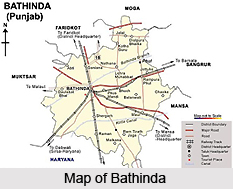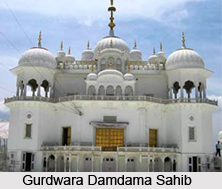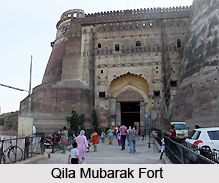 Bathinda, also called Bhatinda, is one of the oldest and most renowned cities of the state of Punjab in the northwestern part of the Indian subcontinent. It is believed that Guru Gobind Singh Ji once defied and fought the powerful Mughal forces in the jungles of Bathinda. Moreover, this city also had an important function in the nation`s struggle of freedom against the British rule and the oppressive administration of the princely monarchs. Bathinda is at present being rapidly industralised. Recent developments include a modern thermal power plant, fertilizer factories, and a large oil refinery. The city is rich in food grain and cotton. There are large grape growing areas. Bathinda is also a principal railway junction and the administrative headquarters of the Bathinda District are located here. The American International firm Pepsi processes process horticultural products grown in Bathinda, Punjab.
Bathinda, also called Bhatinda, is one of the oldest and most renowned cities of the state of Punjab in the northwestern part of the Indian subcontinent. It is believed that Guru Gobind Singh Ji once defied and fought the powerful Mughal forces in the jungles of Bathinda. Moreover, this city also had an important function in the nation`s struggle of freedom against the British rule and the oppressive administration of the princely monarchs. Bathinda is at present being rapidly industralised. Recent developments include a modern thermal power plant, fertilizer factories, and a large oil refinery. The city is rich in food grain and cotton. There are large grape growing areas. Bathinda is also a principal railway junction and the administrative headquarters of the Bathinda District are located here. The American International firm Pepsi processes process horticultural products grown in Bathinda, Punjab.
The city of Bathinda in Punjab has a very extensive history. In 40,000 BC people began inhabiting artificial huts in northern Punjab and central Asia. In 7,000 BC people started growing barley in this area and raising sheep and goats. At that time, people lived in mud brick dwellings in villages, some of which are still extant. Around 3,000 BC farming villages were set up in the Bathinda area, most of which are still there. Ultimately, after many invasions and warfare, the Kushan Kingdom was set up in the area. It is supposed that Rao Bhatti set up the present town of Bathinda in the vicinity of the Lakhi jungle in the third century but the Brars forcefully took possession of the region. Bala Rao Bhatti settled in the city in AD 965. The city was named Bhatinda after his caste name. It was the capital city of Raja Jaipal. In 1004 AD, Mahmud of Ghazni captured a local fort, which was situated on the way from the northwest into the prosperous Ganges valley. In 1189, Muhammad Ghori forcibly took possession of the fort of Bathinda. Prithvi Raj Chauhan, the monarch of this region, managed to recover the fort thirteen months later in 1191 after a violent battle.
 Razia Sultan, the first female ruler of India, was jailed at Bathinda in April 1240. The Sidhu- Brars were thrown out of Bathinda during the rule of the Lodhis, but they were recalled to the area during the reign of Babur. Many other rulers successively ruled the area. Some of the notable ones are Roop Chand, Sardar Jodh Singh Saboke, Ala Singh and Maharaja Karam Singh of Patiala.
Razia Sultan, the first female ruler of India, was jailed at Bathinda in April 1240. The Sidhu- Brars were thrown out of Bathinda during the rule of the Lodhis, but they were recalled to the area during the reign of Babur. Many other rulers successively ruled the area. Some of the notable ones are Roop Chand, Sardar Jodh Singh Saboke, Ala Singh and Maharaja Karam Singh of Patiala.
At the time of the first Anglo- Sikh War of 1845- 46, Maharaja Karam Singh of Patiala sided with the British. He succumbed to his injuries during the war, but his son and heir Maharaja Narinder Singh continued helping the British government. Narinder Singh was followed by Rajinder Singh, Bhupinder Singh, and lastly, in 1938, by Yadavindera Singh. Patiala and East Punjab States Union (PEPSU) were created on May 5, 1948. As a sequel, Bathinda District came into existence on August 20, 1948. The headquarters were at first at Faridkot, but were shifted to Bathinda in 1953. After 1953, the geographical boundaries of the Bathinda District underwent many changes.
The temperature of Bathinda ranges from a maximum of 50°C (122°F) in summer to a minimum of 0°C (32°F) in winter. The weather is normally dry, but is very sultry from the middle of May to the end of August. The rain mainly comes from the southwest direction due to the monsoon winds, and pervades the period between Julys to the middle of September. As per the 2001 India census, Bathinda has a population of 217,389. Males make up 54% of the population and females comprise 46%. The city has an average literacy rate of 70%, higher than the nationwide average of 59.5%. 57% of the males and 43% of the female are literate. 11% of the population is made up of children less than 6 years of age.
A well-known place of attraction in Bathinda in Punjab is the Qila Mubarak fort. This 1900-year-old fort is a Historical national monument. Emperor Kanishka and Raja Dab built it during 90- 110 AD. Bathinda is also famed for having one of the largest military cantonments in Asia. Goniana, Mansa, Rampura Phul, Bhucho Mandi, Talwandi Sabo, Nathana, Tungwali are all small towns near Bathinda. There are direct trains from Delhi to Bathinda in Punjab that pass through Patiala, Ambala, and Rohtak, Jind route.
 The journey takes more or less six hours. Apart from the Qila Mubarak fort, other places of attraction in the place are Dhobi Bazar and Model Town.
The journey takes more or less six hours. Apart from the Qila Mubarak fort, other places of attraction in the place are Dhobi Bazar and Model Town.
Bathinda is one of the biggest railway junctions of India. The Bathinda city harbours two thermal power plants, namely Guru Nanak Dev Thermal Plant in Bathinda City and Guru Hargobind Thermal Plant in Lehra Mohabbat. There is also the Guru Gobind Singh Oil Refinery and a National Fertilizers Plant. All main nationalized and regional banks function in Bathinda. Some of these are the State Bank of India, the State Bank of Patiala, the ICICI Bank and the HDFC Bank. There are many schools and colleges in Bathinda. Some of the notable ones are the Government Rajindra College, the Bathinda Institute of Management and Technology, the Bathinda Engineering College, the Giani Zail Singh College Of Engineering and Technology, the Adesh Institute of Medical Research, the Punjab Technical University, the Baba Shiri Chand Ji Government College, the Saint Xavier`s Senior Secondary School.



















